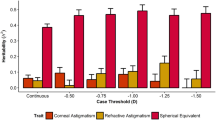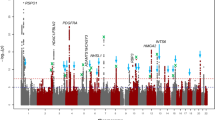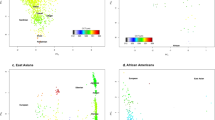Abstract
No genes influencing oculometric phenotypes have yet been identified, despite it being well known that eye morphometry is involved in refraction and that genetics may play an important role. We have therefore performed a heritability analysis and genome-wide search (GWS) of biometric ocular traits in an isolated Sardinian population, assessing the genetic contribution and identifying the associated genetic loci. A complete eye examination including refraction and ocular biometry measurements such as axial length (AL), anterior chamber depth (ACD) and corneal curvature (CC), was performed on 789 subjects. Heritability analysis was carried out by means of parent–offspring regression and variance component models. Univariate and bivariate linkage analysis was performed by using 654 microsatellite markers spanning the genome. CC showed a mean heritability of 57%. AL and ACD were found to have significantly different variances (P<0.01) in males and females, so that heritability was calculated separately for each sex. AL had an estimated heritability in females of 31% and in males of 60%, whereas ACD had an estimated heritability of 47% in females and of 44% in males. In the GWS, the most suggestive evidence of linkage was identified on chromosome 2 for AL (LOD 2.64), on chromosome 1 for ACD (LOD 2.32) and on chromosomes 7, 2 and 3 for CC (LOD 2.50, 2.44 and 2.34, respectively). High heritability of eye morphometry traits was thus revealed. The identified loci are the first linkage signals available in ocular biometry. Notably, the observed significant differences in parental transmission deserve further study.


Similar content being viewed by others
References
Adams AJ (1987) Axial length elongation, not corneal curvature, as a basis of adult onset myopia. Am J Optom Physiol Opt 64:150–152
Almasy L, Blangero J (1998) Multipoint quantitative-trait linkage analysis in general pedigrees. Am J Hum Genet 62:1198–1211
Almasy L, Dyer TD, Blangero J (1997) Bivariate quantitative trait linkage analysis: pleiotropy versus co-incident linkages. Genet Epidemiol 14:953–958
Alsbirk PH (1975) Anterior chamber of the eye. A genetic and anthropological study in Geenland Eskimos. Hum Hered 25:418–427
Alsbirk PH (1977) Variation and heritability of ocular dimensions. A population study among adult Greenland Eskimos. Acta Ophthalmol (Copenh) 55:443–456
Angius A, Melis PM, Morelli L, Petretto E, Casu G, Maestrale GB, Fraumene C, Bebbere D, Forabosco P, Pirastu M (2001) Archival, demographic and genetic studies define a Sardinian sub-isolate as a suitable model for mapping complex traits. Hum Genet 109:198–209
Blackie CA, Harris WF (1997) Refraction and keratometry: departures from and transformation toward multivariate normality. Optom Vis Sci 74:452–458
Brown NP, Koretz JF, Bron AJ (1999) The development and maintenance of emmetropia. Eye 13:83–92
Ciulla TA, Sklar RM, Hauser SL (1988) A simple method for DNA purification from peripheral blood. Anal Biochem 174:485–488
Drack AV (1998) Inheritance of refractive errors. In: Traboulsi EI (ed) Genetic disease of the eye. Oxford University Press, New York, pp 163–174
Falconer DS, Mackay TFC (1996) Introduction to quantitative genetics, 4th edn. Longman, New York
Grosvenor T, Scott R (1993) Three-year changes in refraction and its components in youth-onset and early adult-onset myopia. Optom Vis Sci 70:677–683
Hammond JC, Snieder H, Gilbert CE, Spector TD (2001) Genes and environment in refractive error: the twin eye study. Invest Ophthalmol Vis Sci 42:1232–1236
Hammond JC, Andrew T, Mak YT, Spector TD (2004) A susceptibility locus for myopia in the normal population is linked to the PAX6 gene region on chromosome 11: a genomewide scan of the dizygotic twins. Am J Hum Genet 75:294–304
Hitchins MP, Moore GE (2002) Genomic imprinting in fetal growth and development. Expert Rev Mol Med 4:1–19
Kempen JH, Mitchell P, Lee KE, Tielsch JM, Broman AT, Taylor HR, Ikram MK, Congdon NG, O’Colmain BJ (2004) The prevalence of refractive errors among adults in the United States, western Europe, and Australia. Arch Ophthalmol 122:495–505
Kruglyak L (1999) Genetic isolates: separate but equal? Proc Natl Acad Sci USA 96:1170–1172
Larsen JS (1971) The sagittal growth of the eye. IV. Ultrasonic measurement of the axial length of the eye from birth to puberty. Acta Ophthalmol 49:873–886
Lin LL, Shih YF, Lee YC, Hung PT, Hou PK (1996) Changes in ocular refraction and its components among medical students—a 5-year longitudinal study. Optom Vis Sci 73:495–498
Lyhne N, Sjølie AK, Kyvik KO, Green A (2001) The importance of genes and environment for ocular refraction and its determiners: a population based study among 20–45 year old twins. Br J Ophthalmol 85:1470–1476
Mancosu G, Ledda G, Melis PM (2003) PedNavigator: a pedigree drawing servlet for large and inbred populations. Bioinformatics 19:669–670
McBrien NA, Adams DW (1997) A longitudinal investigation of adult-onset and adult-progression of myopia in an occupational group. Refractive and biometric findings. Invest Ophthalmol Vis Sci 38:321–333
McBrien NA, Millodt M (1987) A biometric investigation of late onset myopic eyes. Acta Ophthalmol Scand 65:461–468
Risch NJ (2000) Searching for genetic determinants in the new millennium. Nature 405:847–856
Saw SM, Carkeet A, Chia KS, Stone RA, Tan DTH (2002) Component dependent risk factors for ocular parameters in Singapore Chinese children. Ophthalmology 109:2065–2071
Sitorus R, Ardjo SM, Lorenz B, Preising M (2003) CY1B1 gene analysis in primary congenital glaucoma in Indonesian and European patients. J Med Genet 40:e9
Sorsby A, Sheridan M, Leary GA, Benjamin B (1960) Vision, visual acuity, and ocular refraction of young men. Br Med J 5183:1394–1398
Sorsby A, Benjamin B, Sheridan M (1961) Refraction and its components during the growth of the eye from the age of three. MRC special report series no. 301. HMSO, London
Stambolian D, Ibay G, Reider L, Dana D, Moy C, Schlifka M, Holmes T, Ciner E, Bailey-Wilson JE (2004) Genomewide linkage scan for myopia susceptibility loci among Ashkenasi Jewish families shows evidence of linkage on chromosome 22q12. Am J Hum Genet 75:448–459
Stenstrom S (1948) Investigation of the variation and the correlation of the optical elements of human eyes. Am J Optom Arch Am Acad Optom 58:1–71
Stoilov I, Akarsu AN, Sarfarazi M (1997) Identification of three different truncating mutations in cytochrome P4501B1 (CYP1B1) as the principal cause of primary congenital glaucoma (Buphthalmos) in families linked to the GLC3A locus on chromosome 2p21. Hum Mol Genet 6:641–647
Teikari J, O’Donnel JJ, Kapiro J, Koskenvuo M (1989) Genetic and environmental effects on oculometric traits. Optom Vis Sci 66:594–599
Wickremasinghe S, Foster PJ, Uranchimeg Lee PS, Devereux Alsbirk PH, Machin D, Johnson GJ, Baasanhu J (2004) Ocular biometry and refraction in Mongolian adults. Invest Ophthalmol Vis Sci 45:776–783
Wilkins JF, Haig D (2003) What good is genomic imprinting: the function of parent-specific gene expression. Nat Rev Genet 4:359–368
Williams JT, Van Eerdewegh P, Almasy L, Blangero J (1999) Joint multipoint linkage analysis of multivariate qualitative and quantitative traits. I. Likelihood formulation and simulation results. Am J Hum Genet 65:1134–1147
Wojciechowski R, Cogdon N, Anninger W, Broman AT (2003) Age, gender, biometry, refractive error, and the anterior chamber angle among Alaskan Eskimos. Ophthalmology 110:365–375
Wong TY, Foster PJ, Ng TP, Tielsch JM, Johnstone GJ, Seah SKL (2001) Variations in ocular biometry in a adult Chinese population in Singapore: the Tanjong Pagar survey. Invest Ophthalmol Vis Sci 42:73–80
Zhou G, Williams RW (1999) Eye1 and Eye2: gene loci that modulate eye size, lens weight, and retinal area in the mouse. Invest Ophthalmol Vis Sci 40:817–825
Acknowledgements
We thank Gianmaria Mancosu for technical support in pedigree extraction, and Paola Melis, Teresa Manias and Pino Ledda for Talana genealogy reconstruction. We also wish to express our gratitude to Charles Peterson and Tom Dyer for their assistance with the SOLAR software and Michael Whalen for a careful reading of the manuscript. We are very grateful to the population of Talana for their collaboration and to the municipal administration for their economic and logistic support. This research was funded by Shardna Life Sciences (http://www.shardna.it), a joint venture between a private company and the National Council of Research of Italy.
Author information
Authors and Affiliations
Corresponding author
Additional information
The authors Ginevra Biino and Maria Antonietta Palmas contributed equally to this work
Rights and permissions
About this article
Cite this article
Biino, G., Palmas, M.A., Corona, C. et al. Ocular refraction: heritability and genome-wide search for eye morphometry traits in an isolated Sardinian population. Hum Genet 116, 152–159 (2005). https://doi.org/10.1007/s00439-004-1231-6
Received:
Accepted:
Published:
Issue Date:
DOI: https://doi.org/10.1007/s00439-004-1231-6




